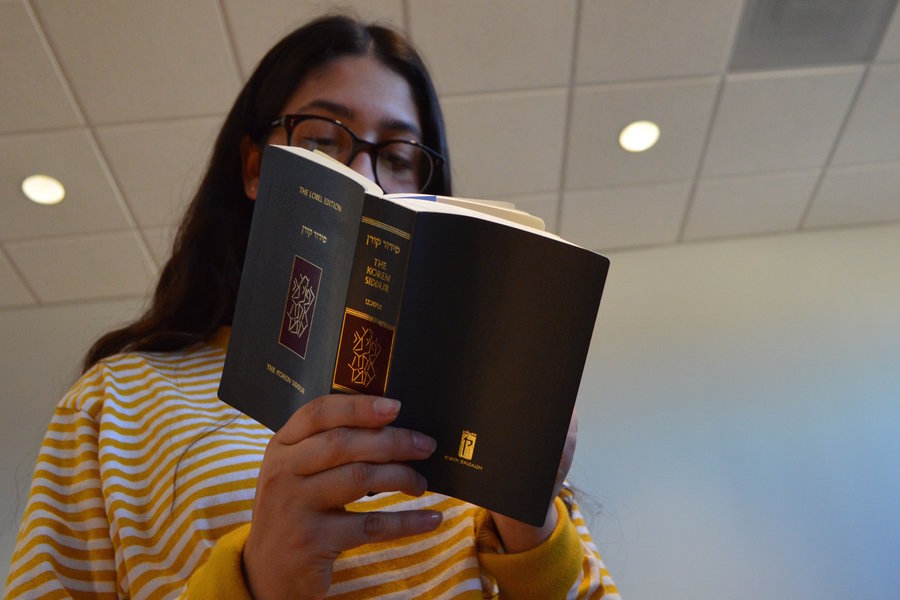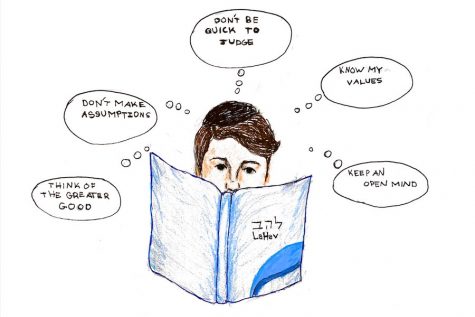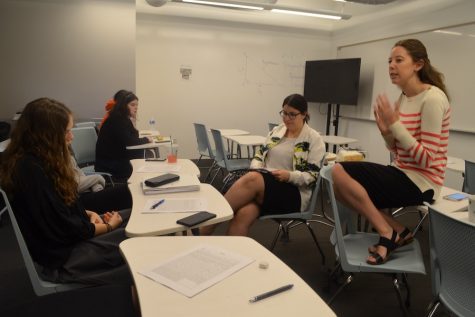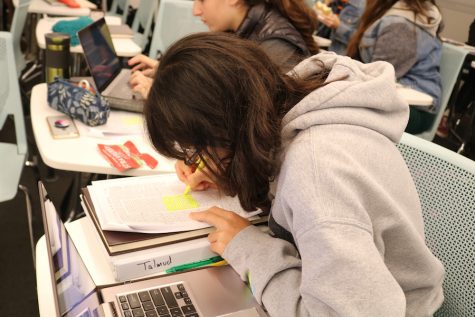School replaces aging Artscroll siddurim with new Koren-Sacks
PRAYERS: Every morning and afternoon Shalhevet students pick up a new Koren-Sacks siddur for prayer services.
Shalhevet welcomed about 260 new siddurim to the school last month. After at least 15 years of using Artscroll prayerbooks, the Judaics Studies faculty decided the new Koren siddur would be a better fit, and bought paperback copies of the Koren Sacks Weekday Siddur, Lobel Edition.
The new books are now in use throughout the building.
“We thought that we could use a little change,” said Judaics Studies teacher and Mashgiach Ruchani Rabbi David Block, who coordinates davening. “Artscroll is wonderful, but Koren has a lot of things that speak to our values more as a Modern Orthodox school.”
Rabbi Block announced the arrival of the new siddurim Nov. 2, with a Powerpoint presentation at Town Hall in which he detailed the advantages of the new prayer books.
He explained that Koren siddur is much newer than the Artscroll, which was first published in the 1980s. The Koren Lobel Edition was first published in 2014.
Then, as students watched in anticipation and surprise, science teacher Tushar Dwivedi was carried into the gym on a chair by a group of male upperclassmen in the style of a bar or bat mitzvah, holding up one of the new siddurim and giving everyone their first look at them.
Students joined in on the celebration and began dancing in circles around Mr. Dwivedi while Jewish music played from the sound system in the gym.
Rabbi Block said another reason Koren was chosen was that it isn’t used in any of Shalhevet’s feeder schools.

CONNECTING: None of Shalhevet’s feeder schools use Koren siddurim, so all
incoming students will have to learn the book together.
“When we get to Shalhevet, students who come from all different types of schools will feel like they’re starting on the same page,” said Rabbi Block in an interview.
Another feature of the Koren is its new English translation by Rabbi Lord Jonathan Sacks, former chief rabbi of the United Kingdom. In addition, there is a commentary throughout the siddur that includes perspectives of Rav Yosef Soloveitchik and other Modern Orthodox thinkers.
It also contains prayers for the U.S., Israeli and Canadian governments, prayers for after childbirth and on the birth of a daughter, and prayers in observance of Israeli national holidays.
Visually, the Koren’s text is broken up into smaller paragraphs than the Artscroll’s, so the Hebrew aligns directly with the English translation across the binding, to help daveners better understand the text while moving through the prayers.
Another consideration was the condition of the aging Artscrolls, many of which were missing the most commonly used pages. This had been noticed by students and administration alike.
When Dr. Weissman and Head of School Rabbi Ari Segal held meetings this year with each grade to discuss general questions students might have, in the 11th-grade meeting junior Honor Fuchs asked if the school would be purchasing new siddurim.
It was her second try at getting new prayer books.
“I previously made an Agenda proposal to get new siddurs earlier this year, because I noticed they were all missing so many pages, and nothing was ever done with that for whatever reason,” said Honor in an interview.
But when she asked in the grade-wide meeting, Rabbi Segal and Dr. Weissman said they were working on it. They said they realized some of the Artscroll siddurim were falling apart and that they were in the process of trying to get new ones.
Rabbi Segal explained that the school was previously not as financially stable, so they did not even think about purchasing new siddurim until recently.
A week later, the new siddurs arrived.
Officials declined to say what they spent, but the Koren paperbacks sell for about $19 each on Amazon.
Reactions to the new prayerbooks from the student body have been mixed.
Senior Tali Schlacht appreciates the inclusion of prayers for Israeli independence day, for soldiers defending Israel, and for Israel itself.
“I really like them because they represent our school much better,” said Tali. “They have tefilot for Yom Haatzmaut , mi shebeirach for Tzahal and Avinu shebashamayim and all that stuff that the other siddurim we had did not have. I think it’s great that we made the switch.”
Rabbi Block agreed.
“As an Orthodox, religious, Zionist school, we want a siddur that has all of that,” he said.
Others were less impressed.
“The new siddurim are plain and simple,” said freshman Yehuda Zadeh. “They are being overhyped for no reason.”
Sophomore Sabrina Jahan agreed.
“I think the new siddurs are more presentable, but I don’t see why they were necessary,” said Sabrina.
Freshman Mimi Czuker said that although she liked the new books, it made her slightly uncomfortable that the Hebrew is now on the left side of the page and the English on the right. The Artscroll has the reverse.
Students who like the books appreciate some of the new features that separate the Koren from the Artscroll. And everyone appreciates the better condition.
“I felt like in the old siddurim there were always pages missing every time I was davening,” said sophomore Maya Schapira.
Rabbi Block says the school plans to use the old siddurim on Shabbatons for now. If the time comes when the school does not need the siddurim at all, he hopes they will be able to pass them on to someone who will put them to good use.











